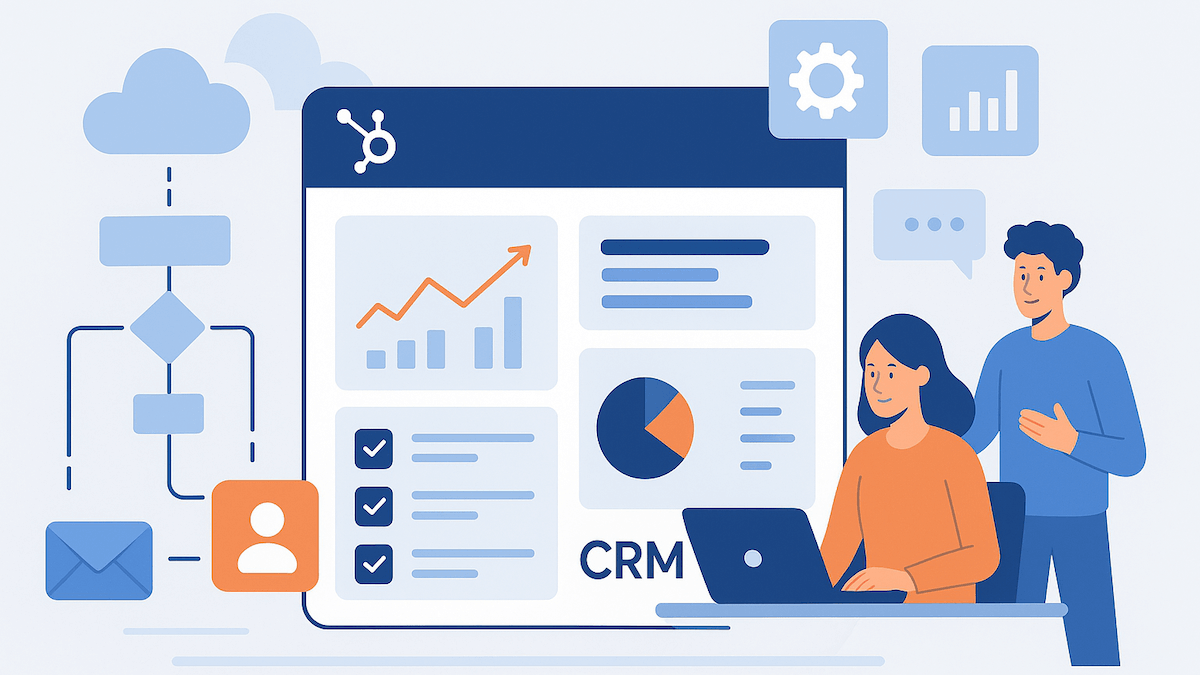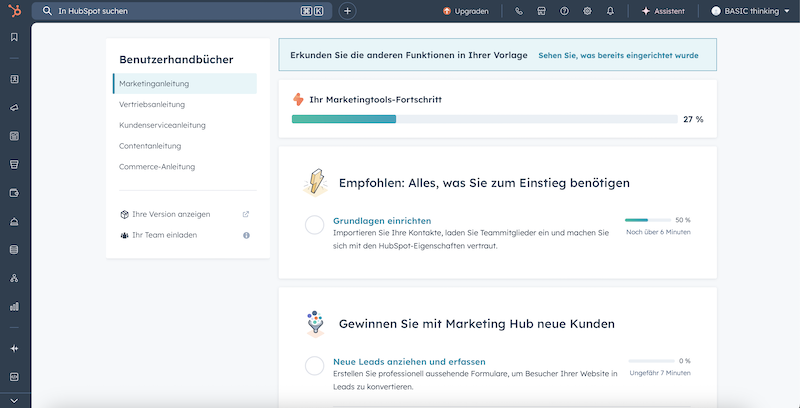The article Generate leads and automate onboarding: CRM for SaaS startups first appeared in the online magazine BASIC thinking. With our newsletter UPDATE you can start the day well informed every morning.

SaaS startups are under enormous pressure to innovate and grow. New customers must be acquired quickly, processes must be designed efficiently and user loyalty must be secured over the long term. A modern CRM like HubSpot has long been more than just contact management for young software companies – it is the control center for lead generation, automated onboarding and data-based growth.
Why SaaS startups need a CRM
SaaS companies differ significantly in their requirements from classic service providers or trading companies. They do not sell physical products but digital solutions that often require explanation and require a quick, smooth start.
Typical challenges are:
- Fast scaling: New users should be acquired and activated as automatically as possible without overloading the team.
- Complex customer journey: From the first contact to the paying user, there are many touchpoints – website, demo request, test phase, support, upselling.
- Data-driven decisions: Every step in marketing, sales and product development is based on key figures that must be recorded and evaluated centrally.
- Automation: Many processes – from lead qualification to welcoming new users – should take place without manual intervention.
- Growing competition: In the SaaS industry, competition is high and expectations for service and speed are constantly increasing.
What a CRM has to do for SaaS startups
A CRM system like HubSpot for SaaS companies should offer the following core features:
- Lead capture and qualification: Automatic tracking of website visitors, demo requests and registrations. Leads are segmented and evaluated based on interests, industries and interactions.
- Automated onboarding: New users receive automated welcome emails, tutorials and personal contacts. The customer journey is designed individually.
- Integration with marketing and product tools: The CRM must be able to connect to common SaaS tools such as email marketing, webinar software, support systems and analytics.
- Reporting and dashboards: All important key figures – from conversion rate to churn to customer lifetime value – are available at any time.
- Workflow automation: Routine tasks such as follow-ups, contract conclusions or upgrades are automated.
- Scalability and Flexibility: The system grows with the startup and can be adapted to new requirements.
- GDPR compliance: Especially for international customers, the CRM must meet all data protection requirements.
The most important CRM workflows for SaaS startups
- Lead scoring and segmentation: The CRM automatically assesses how relevant a lead is – for example based on industry, company size, website interaction or test registration. This allows the sales team to specifically pursue the best opportunities.
- Automated onboarding: After registering, new users receive a series of emails with tutorials, tips and information about the product. Anyone who has not yet used certain features receives targeted encouragement so that the added value quickly becomes clear.

At HubSpot, SaaS startups are supported from the start - Demo requests and test phases: Interested parties can book a demo or start a test phase via the website. The CRM automatically creates tasks and reminders for each contact so that no lead is lost.
- Upselling and cross-selling: The system recognizes when a customer is particularly active or has new requirements – and triggers automated offers for upgrades or additional functions.
- Support and Feedback: All support requests are recorded centrally in the CRM. A satisfaction survey can be sent automatically after every ticket or chat.
Practical example: A SaaS startup digitizes sales and onboarding with CRM from HubSpot
Initial situation:
A young SaaS company offers project management software for small businesses. Every month around 300 new interested parties register for a free test phase on the website. So far, contacts have been managed via email and Excel; onboarding is done manually by the sales team.
Problem:
- Many Leads are lost because follow-ups are forgotten.
- Onboarding is time-consuming and not individual enough.
- Key figures for conversion rates and user activity are difficult to evaluate.
Implementation with a CRM like HubSpot:
- The CRM automatically takes all website registrations and demo requests and rates them based on relevance.
- New users receive automated email streams with tutorials, video guides and tips on product usage.
- Get sales and support automatically receive notifications about new test users and can follow up specifically.
- Dashboards show conversion rates, activation rates and churn on a daily basis.
- After the test phase ends, users receive automated offers for an upgrade or additional functions.
- Support tickets and feedback are documented and evaluated centrally.
Result:
- The conversion rate from test user to paying customer increases by 22 percent.
- The team saves over 30 hours per month through automated processes.
- The User satisfaction increasesbecause the team looks after you individually and quickly.
Typical workflows and automations in CRM for SaaS startups
| Workflow/Automation | Benefits for the startup |
|---|---|
| Lead scoring | Sales focuses on the best opportunities |
| Automated onboarding | Users are instructed quickly and individually |
| Demo and test phase management | No lead goes unnoticed, follow-up is automated |
| Upselling offers | More sales through targeted offers to active users |
| Support workflows | Fast processing and feedback evaluation |
Step-by-step instructions: How SaaS startups implement a CRM
- Create CRM account: Register your startup with the provider (e.g HubSpot), select the appropriate region for data protection and start with the setup wizard.
- Connect website and landing pages: Connect forms, demo requests and test registrations directly to the CRM.
- Set up lead scoring and segmentation: Set criteria for evaluation and let the system automatically award points.
- Create automated onboarding routes: Set up email campaigns for new users with tutorials, tips, and product features.
- Configure conversion and user activity dashboards: Create individual overviews for sales, marketing and product teams.
- Integrate support and feedback: Connect the CRM with support tools to document and evaluate all requests centrally.
- Enable upselling and cross-selling workflows: Set up automated offers for upgrades and additional features.
Reporting and key figures: making growth measurable
A CRM like HubSpot offers SaaS startups powerful evaluation options.
Typical key figures are:
- Conversion rate: How many leads convert into paying users?
- Activation rate: How many new users are actively using the product?
- Churn rate: How many customers cancel or remain inactive?
- Customer Lifetime Value: How much revenue does an average customer bring in?
- Support times and satisfaction: How quickly does the team process requests? How satisfied are the users?
With individually configurable dashboards, founders and teams keep an eye on all important KPIs. In this way, weak points can be quickly identified and targeted measures for improvement can be initiated.
FAQ: CRM for SaaS startups – the most important questions
Is a CRM suitable for small and large SaaS companies?
Yes, modern systems like that HubSpot are scalable and adapt to any team size.
Can I connect my CRM with product and marketing tools?
Most providers offer numerous integrations to common SaaS tools.
How does automation specifically help?
Workflows save time, prevent errors and ensure consistently high service quality.
How secure is my customer data?
CRM systems like HubSpot comply with the GDPR and offer comprehensive security functions.
How quickly can I start?
The setup usually only takes a few hours. The first automations and dashboards are quickly available.
Conclusion: Grow faster and delight customers with the HubSpot platform
A CRM like HubSpot’s has long been indispensable for SaaS startups. It bundles all leads, automates onboarding and provides the most important metrics for sustainable growth. With individual workflows, real-time reporting and seamless integration into the product and marketing landscape, young software companies not only win more customers – they also retain them in the long term.
The post Generate leads and automate onboarding: CRM for SaaS startups appeared first on BASIC thinking. Follow us too Google News and Flipboard or subscribe to our newsletter UPDATE.
As a Tech Industry expert, I believe that generating leads and automating onboarding processes are crucial aspects for the success of SaaS startups. A CRM system can greatly help in managing leads effectively and streamlining the onboarding process for new users.
By utilizing a CRM system, SaaS startups can track and manage leads from multiple sources, prioritize them based on their potential value, and automate follow-up communications to convert them into paying customers. This can help in increasing the efficiency of the sales process and ultimately lead to higher conversion rates.
On the other hand, automating the onboarding process using a CRM system can help in providing a seamless and personalized experience for new users. By setting up automated workflows and personalized onboarding sequences, startups can ensure that users are guided through the product setup and usage process in a structured manner, leading to higher user retention and satisfaction.
Overall, implementing a CRM system for lead generation and onboarding automation can greatly benefit SaaS startups by increasing efficiency, improving conversion rates, and enhancing the overall user experience. It is a worthwhile investment that can help startups scale and grow their customer base effectively.
Credits